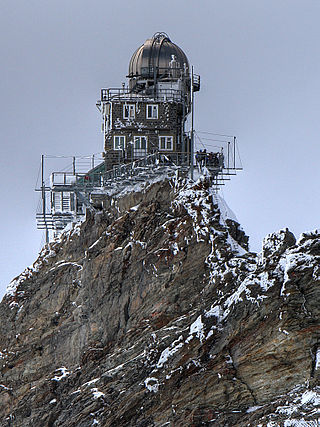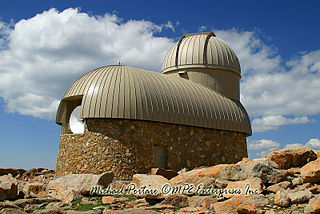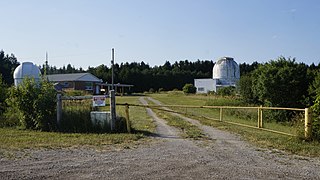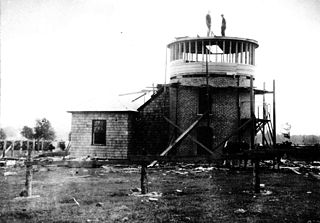
An observatory is a location used for observing terrestrial, marine, or celestial events. Astronomy, climatology/meteorology, geophysics, oceanography and volcanology are examples of disciplines for which observatories have been constructed. Historically, observatories were as simple as containing an astronomical sextant or Stonehenge.

The Mauna Kea Observatories (MKO) are a group of independent astronomical research facilities and large telescope observatories that are located at the summit of Mauna Kea on the Big Island of Hawaiʻi, United States. The facilities are located in a 525-acre (212 ha) special land use zone known as the "Astronomy Precinct", which is located within the 11,228-acre (4,544 ha) Mauna Kea Science Reserve. The Astronomy Precinct was established in 1967 and is located on land protected by the Historical Preservation Act for its significance to Hawaiian culture. The presence and continued construction of telescopes is highly controversial due to Mauna Kea's centrality in native Hawaiian religion and culture, as well as for a variety of environmental reasons.

Eleanor Margaret Burbidge, FRS (née Peachey; 12 August 1919 – 5 April 2020) was a British-American observational astronomer and astrophysicist. In the 1950s, she was one of the founders of stellar nucleosynthesis and was first author of the influential B2FH paper. During the 1960s and 1970s she worked on galaxy rotation curves and quasars, discovering the most distant astronomical object then known. In the 1980s and 1990s she helped develop and utilise the Faint Object Spectrograph on the Hubble Space Telescope. Burbidge was well known for her work opposing discrimination against women in astronomy.

Henrietta Hill Swope was an American astronomer who studied variable stars. In particular, she measured the period-luminosity relation for Cepheid stars, which are bright variable stars whose periods of variability relate directly to their intrinsic luminosities. Their measured periods can therefore be related to their distances and used to measure the size of the Milky Way and distances to other galaxies.

The Center for Astrophysics | Harvard & Smithsonian (CfA), previously known as the Harvard–Smithsonian Center for Astrophysics, is an astrophysics research institute jointly operated by the Harvard College Observatory and Smithsonian Astrophysical Observatory. Founded in 1973 and headquartered in Cambridge, Massachusetts, United States, the CfA leads a broad program of research in astronomy, astrophysics, Earth and space sciences, as well as science education. The CfA either leads or participates in the development and operations of more than fifteen ground- and space-based astronomical research observatories across the electromagnetic spectrum, including the forthcoming Giant Magellan Telescope (GMT) and the Chandra X-ray Observatory, one of NASA's Great Observatories.

The Dunsink Observatory is an astronomical observatory established in 1785 in the townland of Dunsink in the outskirts of the city of Dublin, Ireland.

Meyer–Womble Observatory (MWO) is an astronomical observatory owned and operated by the University of Denver. It is located near the summit of Mount Evans in the Arapaho National Forest approximately 60 kilometers (37 mi) west of Denver, Colorado (USA). At an elevation of 4,326 meters (14,193 ft), it is the third-highest optical/infrared observatory in the world, and was the highest until the Indian Astronomical Observatory opened in 2001.

Ladd Observatory is an astronomical observatory at Brown University in Providence, Rhode Island. Founded in 1891 it was primarily designed for student instruction and also research. The facility operated a regional timekeeping service. It was responsible for the care and calibration of clocks on campus including one at Carrie Tower and another that rang the class bell at University Hall. Meteorological observations were made there from the time the building opened using recording weather instruments.

Mount Laguna Observatory (MLO) is an astronomical observatory owned and operated by San Diego State University (SDSU). The telescope was operated in partnership with the University of Illinois at Urbana-Champaign (UIUC) until 2000. MLO is located approximately 75 kilometers (47 mi) east of downtown San Diego, California (USA) on the eastern edge of the Cleveland National Forest in the Laguna Mountains on the SDSU Astronomy Campus near the hamlet of Mount Laguna. MLO was dedicated on June 19, 1968, seven years after SDSU's Department of Astronomy became an independent academic department of SDSU's College of Sciences. The dedication took place during the 1968 summer meeting of the Astronomical Society of the Pacific. Currently SDSU is working with University of Kansas (KU), and UNC Chapel Hill on various projects.

The Robinson Observatory is an astronomical observatory owned and operated by the University of Central Florida College of Sciences in Orlando, Florida, USA.

The Warner and Swasey Observatory is the astronomical observatory of Case Western Reserve University. Named after Worcester R. Warner and Ambrose Swasey, who built it at the beginning of the 20th century, it was initially located on Taylor Road in East Cleveland, Ohio, USA. The observatory, which at that time housed a 9.5-inch (24 cm) refractor, was donated in 1919 to the Case School of Applied Science. The newer 24-inch (61 cm) Burrell Schmidt telescope was built in 1939.

The Community College of Rhode Island (CCRI) is a public community college in Rhode Island. It is the only community college in the state and the largest community college in New England. The college's primary facility is located in Warwick, with additional college buildings throughout the state.

Víctor Manuel Blanco was a Puerto Rican astronomer who in 1959 discovered Blanco 1, a galactic cluster. Blanco was the second Director of the Cerro Tololo Inter-American Observatory in Chile, which had the largest telescope in the Southern Hemisphere at the time. In 1995, the 4-meter telescope was dedicated in his honor and named the Víctor M. Blanco Telescope; it is also known as the "Blanco 4m."
The SFA Observatory (SFA) is an astronomical observatory located 17 km (11 mi) north of Nacogdoches, Texas (USA). The observatory is owned and operated by Stephen F. Austin State University (SFASU), and opened in 1976. It is used for undergraduate instruction and for graduate-level research.
The Dark Sky Observatory (DSO) is an astronomical observatory owned and operated by Appalachian State University (ASU). It is located 9 kilometers (5.6 mi) east of Deep Gap, North Carolina (USA), off of the Blue Ridge Parkway, and 32 kilometers (20 mi) east of the ASU campus in Boone, North Carolina It was established in 1981, and is used for research, instruction, and public viewing events. The Cline Visitors' Center was completed in 2011.

The Elginfield Observatory is an astronomical observatory located in the township of Middlesex Centre, Ontario (Canada), about 25 kilometres (16 mi) north of London, Ontario. The observatory is owned and operated by the University of Western Ontario, and opened in 1969. The observatory features a 1.2 m (47 in) Ritchey–Chrétien telescope built by Boller and Chivens which is used for spectroscopy and photometry. The telescope can be configured to feed instruments at the Cassegrain, Nasmyth, and Coudé foci. Recent research includes monitoring the changing size of Cepheid variable stars, estimating out-gasing of minor planets, and searching for large Perseid meteoroids.

West Mountain Observatory (WMO) is an astronomical observatory located on West Mountain near the community of West Mountain, Utah United States, about 22 km (14 mi) southwest of Provo. The observatory is owned and operated by Brigham Young University (BYU), and opened in 1981 after increasing light pollution reduced the utility of the Orson Pratt Observatory on the BYU campus. The first year of observing with the new 0.9 m telescope included imaging of intrinsic variable stars and high-mass X-ray binaries. Past research topics include light curve analysis of Delta Scuti variable stars and identifying pre-main-sequence stars by searching for H-alpha emitting objects.
Alan Hunter CBE was an English astronomer who spent his career at the Royal Greenwich Observatory, serving as Director between 1973 and 1975.

Seagrave Memorial Observatory is an astronomical observatory located in North Scituate, Rhode Island. It is named after astronomer Frank Evens Seagrave and is wholly owned and operated by Skyscrapers, Inc. The main instrument is an 8¼-inch Alvan Clark refracting telescope which was given to Frank Evens Seagrave for his 16th birthday in 1876, however the telescope took two years to build, so he did not receive it until 1878. The telescope and Seagrave Observatory were originally at 119 Benefit Street in Providence. At the time it was the third largest telescope in New England. The telescope was moved to North Scituate in October 1914 when the construction of the current observatory was completed. The observatory was acquired by the Skycrapers in 1936 after the death of Seagrave.

Skinakas Observatory is an astronomical observatory located on the eponymous peak of Psiloritis, on the island of Crete, Greece. It has a 1.3 m modified Ritchey–Chrétien telescope and a 0.3 m Schmidt–Cassegrain telescope, which are operated by the University of Crete and the Foundation for Research & Technology – Hellas.

















